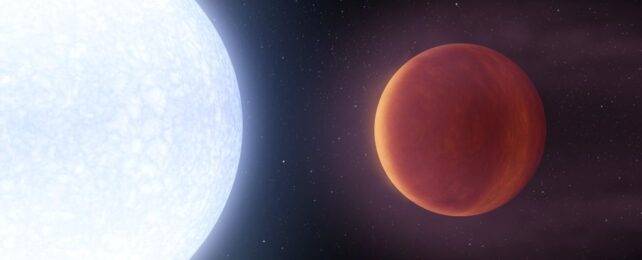One of the wildest exoplanets ever found in the Milky Way has just gotten even more interesting.
In the atmosphere of KELT-9b, astronomers have detected the rare earth metal terbium swirling around in clouds of vaporized metal, the first time this extremely rare element has been found on a distant world.
The team also made new detections of vanadium, barium, strontium, nickel, and other elements, confirming previous detections and suggesting that whatever is going on with KELT-9b is very strange indeed.
"We have developed a new method that makes it possible to obtain more detailed information. Using this, we have discovered seven elements, including the rare substance terbium, which has never before been found in any exoplanet's atmosphere," says astrophysicist Nicholas Borsato of Lund University in Sweden.
"Finding terbium in an exoplanet's atmosphere is very surprising."
KELT-9b is located some 670 light-years away and is truly one of the most extreme exoplanets out there. It's known as a hot Jupiter, a gas giant locked into such a close orbit with its host star that it's heated to scorching temperatures.
On top of that, KELT-9b orbits a blue supergiant star – that's one of the hottest there is – on an extremely tight orbit of just 1.48 days.
This proximity is pretty much vaporizing the exoplanet: On its day side, KELT-9b is heated to temperatures in excess of 4,600 Kelvin (4,327 degrees Celsius, or 7,820 degrees Fahrenheit). That's the hottest temperature we've ever seen in an exoplanet. It's hotter than at least 80 percent of all known stars.
Luckily for us, KELT-9b orbits in such a way that it passes between us and the star. This means that scientists have been able to peer into its atmosphere.
When the starlight passes through the atmosphere of KELT-9b, some wavelengths of light are absorbed and re-emitted by atoms in the gas. The signal is tiny, but by stacking orbits, astronomers can amplify the signal to see brighter and darker parts on the spectrum of the star's light when the planet is transiting, compared to observations of the star on its own.
It takes a bit of analysis, but scientists can look at the signature of these dark and light parts and determine which elements are causing the changes in the light.
With this data, KELT-9b became the first exoplanet in whose atmosphere vaporized iron and titanium were detected in 2018. Then, a year later, scientists announced that they had also found sodium, magnesium, chromium, and rare earth metals scandium and yttrium.
Now, Borsato and his colleagues have refined the analysis techniques to make even more detailed breakdowns of the elements found in the spectrum of KELT-9b and its host star. Their results confirmed previous detections of hydrogen, sodium, magnesium, calcium, chromium, and iron and detected several metals that hadn't been spotted in the exoplanet's atmosphere.
Terbium, with the atomic number 65, was the true surprise. Here on Earth, the heavy element is extremely rare, usually found in trace amounts combined with other elements. We have to date identified no natural terbium-dominant mineral; its estimated abundance in Earth's crust is around 0.00012 percent.
Finding it on another world is interesting because heavy elements like terbium can only be forged in the most violent of circumstances, such as a supernova explosion or a collision between two neutron stars.
This is true for all elements heavier than iron, but the detection of terbium in an exoplanet atmosphere was not at all expected, and it could tell us something about the history of KELT-9b and its star.
We know both are relatively young, as far as these things go: around just 300 million years. (The Sun, for context, is about 4.6 billion years old.) To contain heavy elements like those detected in KELT-9b's atmosphere, they must have formed from materials that included ejecta from one of these violent events.
Since such events occur at the end of a star's lifetime, the quantity of heavy elements in the Universe increases over time.
The older a star or exoplanet is, the less heavy element material it will have. Conversely, younger stars and exoplanets will have more heavy elements and likely a greater variety.
"Learning more about the heavier elements helps us, among other things, to determine the age of the exoplanets and how they were formed," Borsato says.
The team's work also advances the techniques used for analyzing exoplanet atmospheres. The science is still fairly new, but it's growing in leaps and bounds; a new generation of telescopes will expand it exponentially.
This isn't just for studying the extreme outliers, like KELT-9b. Scientists believe that our first detection of life outside the Solar System will be through the detection of biological material in the atmosphere of an alien world.
"Detecting heavy elements in the atmospheres of ultra-hot exoplanets is another step towards learning how the atmospheres of planets work," Borsato says. "The better we get to know these planets, the greater chance we have of finding Earth 2.0 in the future."
The research has been accepted for publication in Astronomy & Astrophysics, and is available on arXiv.
